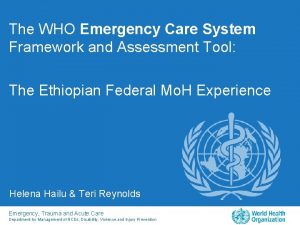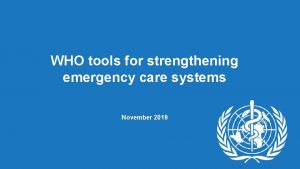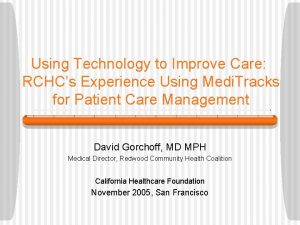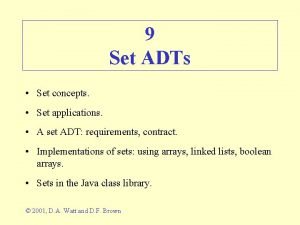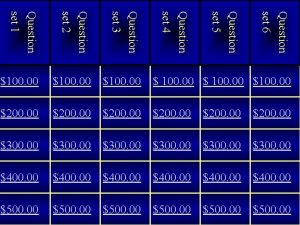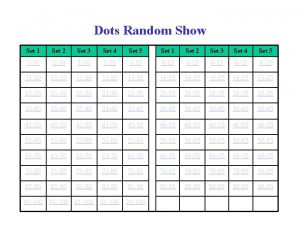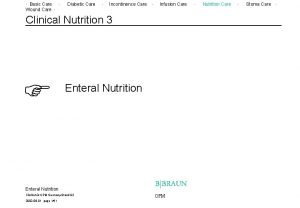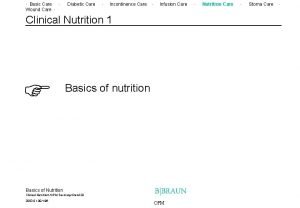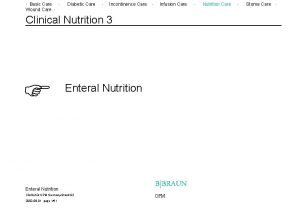Using a QI framework to improve care Set

























- Slides: 25

Using a QI framework to improve care – Set the vision for improvement – Understand the problem – Identify Areas for Improvement – Devise a Measurement Strategy – Prioritize small tests of change • Measure change – Sustain the change 11: 05

Why measure change? • Allows you to understand the impact of your changes • Allows you to feedback performance to those doing well & those struggling to improve performance • Allows group to see progress to goal

Case Example: Run Chart PERCENT OF PATIENTS DISCHARGED BY NOON 2013 20% Audit & Feedback 16% % Discharge by Noon Median 12% 8% 4% Baseline Nov Dec 2012 Jan Feb Mar Apr May Jun Target Tee time implemented July Aug Sep 2013 Oct Nov Dec Jan Feb Case Manager on leave

Improvement in Pain Scores Weeks 1 -12 Avg. 58% Pitfall of averages: Max. 100% Min. 35% • Aggregate data dilutes measurements Avg. 68% Max. 95% • Does not allow evaluation over time Min. 40% Weeks 13 -24

Improvement in pain scores Day 1 to Day 2 100 95 80 90 85 60 80 75 40 70 65 20 60 55 Did We Improve? 23 21 19 17 15 13 11 9 7 5 3 1 0 50

% of pts with pain improvement 70% 60% 50% Intervention period Goal = 57% Baseline period 47% 44% Planning period 67% 52% 41% 40% 30% 20% 10% 0% Jan-Mar April-June July-Sept Oct-Dec Jan-Feb

Try the next test of change

Using a QI framework to improve care – Understand the problem – Convince others there is a problem – Identify areas for improvement – Prioritize small tests of change – Devise a measurement strategy – Measure change • Sustain the change 11: 15

Coaching & Celebrating Success • Identify early wins • Recognition does not have to be big • Recognize this is a marathon – small wins to a big goal

How do we engage others in the problem? • Appeal to both sides of our doctor brain:

Finding your story

Data visualization

Inspiring data

Your data should tell your story 1854 in London. Cholera strikes. In just 10 days, over 500 people have been killed in one neughborhood. No one understands the source. Except John Snow, an epidemiologist who realized the pump at the corner of Cambridge & Broad street must be the source.

Take home Lessons

Fishbone Diagram The Cause Equipment Process The effect People The Problem primary cause secondary cause Materials Environment Management

Identify Areas for Improvement PCS Round s One team membe r does PM check in Inform al ✔ in w/ primary teams Write notes with “official recs” Call the primary team after each patient is seen with clear todo now recs Write note with updated PM recs Gives patient information card on their pain regimen Offer to write orders for the team if they are busy? Call the bedside nurse to let him/her know of new orders? Page team with updated recs Nurse updates the card for patient

Remember the three measurements - Sepsis Mortality - Cost - LOS Outcomes Four Balancing Measures (potential harm) (patient level results) Process: (actions) - Lactate drawn - Blood cultures prior to antibiotics - Time to sepsis bundle delivery - Time to MD evaluation - Allergic Reactions - Antibiotic Resistance - C. Difficile Structure (adherence to the program) - Antibiotics Stocked - EMR alert created - Changes to ED staffing

High Effort Thankless tasks Write Gives patient information card note with on their pain regimen updated PM recs Low Impact One team membe r does PM check in High Impact Easy Wins Low Effort Call the primary team after each patient is seen with clear todo now recs

Improvement in pain scores Day 1 to Day 2 100 95 80 90 85 60 80 75 40 70 65 20 60 55 Did We Improve? 23 21 19 17 15 13 11 9 7 5 3 1 0 50

Coaching & Celebrating Success • Identify early wins • Recognition does not have to be big • Highlight how these short term wins are contributing to the bigger vision

Questions / Comments ? Michelle Mourad: michelle. mourad@ucsf. edu

PDSA Worksheet for Testing Change Aim: (overall goal you wish to achieve) Improve Pain scores by 75% from day 1 to day 2 through prompt team recs Describe your first (or next) test of change: Person responsible Call each team with specific recommendations after each patient visit. Offer to write orders & call nurse at that moment. When to be done Pall Care Starting June 1 Attending Where to be done For all Pall Care consult pts Plan: List the tasks needed to set up this test of change Get Pall Care analyst access to EMR and team info Person responsible Steve Pantilat Ask Pall Care analyst to gather primary team pagers Kelli - Analyst for all patients at the start of the day Pall Care SW to audit if this is happening, and team Jane Hawgood response Do When to be done Within 2 week After above Daily Where to be done APe. X Request Every morning On floors during rounds Describe what actually happened when you ran the test Study Describe the measured results and how they compared to the predictions Act cycle Describe what modifications to the plan will be made for the next from what you learned

As your palliative care team, we want to improve your pain and other symptoms. You have been prescribed an "as needed" pain medication, ______, which you can ask for every ___ hours. If you have pain, push your call button to ask for this medicine. If that medicine does not work within 1 hour, please tell your nurse. It is generally easier to stay out of pain than to get out of pain once it is severe. Please let your nurse know early when your pain is worsening. If you want to talk with our team directly, ask your nurse to page the palliative care team. We are committed to working with your primary team to help you feel better.

Individual Exercise: 10 minutes What change do you want to test? Aim: (overall goal you wish to achieve) Every goal will require multiple smaller tests of change Describe your first (or next) test of change: Person responsible When to be done Where to be done Person responsible When to be done. Where to be done Plan: List the tasks needed to set up this test of change Do Describe what actually happened when you ran the test Study Describe the measured results and how they compared to the predictions Act Describe what modifications to the plan will be made for the next cycle from what you learned 10: 55
 Total set awareness set consideration set
Total set awareness set consideration set Training set validation set test set
Training set validation set test set Types of care primary secondary tertiary
Types of care primary secondary tertiary Bounded set vs centered set
Bounded set vs centered set Fucntions
Fucntions Crisp set vs fuzzy set
Crisp set vs fuzzy set Crisp set vs fuzzy set
Crisp set vs fuzzy set What is the overlap of data set 1 and data set 2?
What is the overlap of data set 1 and data set 2? Surjective vs injective
Surjective vs injective En el framework de colecciones de java un set es:
En el framework de colecciones de java un set es: Dispositional framework vs regulatory framework
Dispositional framework vs regulatory framework Conceptual framework explanation example
Conceptual framework explanation example Framework sample
Framework sample Theoretical framework
Theoretical framework Dispositional framework vs regulatory framework
Dispositional framework vs regulatory framework Conceptual framework vs theoretical framework
Conceptual framework vs theoretical framework Proving set identities examples
Proving set identities examples Who emergency care system framework
Who emergency care system framework Emergency care system framework
Emergency care system framework The fundamentals of care framework
The fundamentals of care framework System.collections.generics
System.collections.generics Unit 25 special refrigeration system components
Unit 25 special refrigeration system components Standard 3 duty of care
Standard 3 duty of care Proprietatea fierului de a fi atras de magnet
Proprietatea fierului de a fi atras de magnet Palliative care vs hospice care
Palliative care vs hospice care Inmultirea la animale
Inmultirea la animale

















